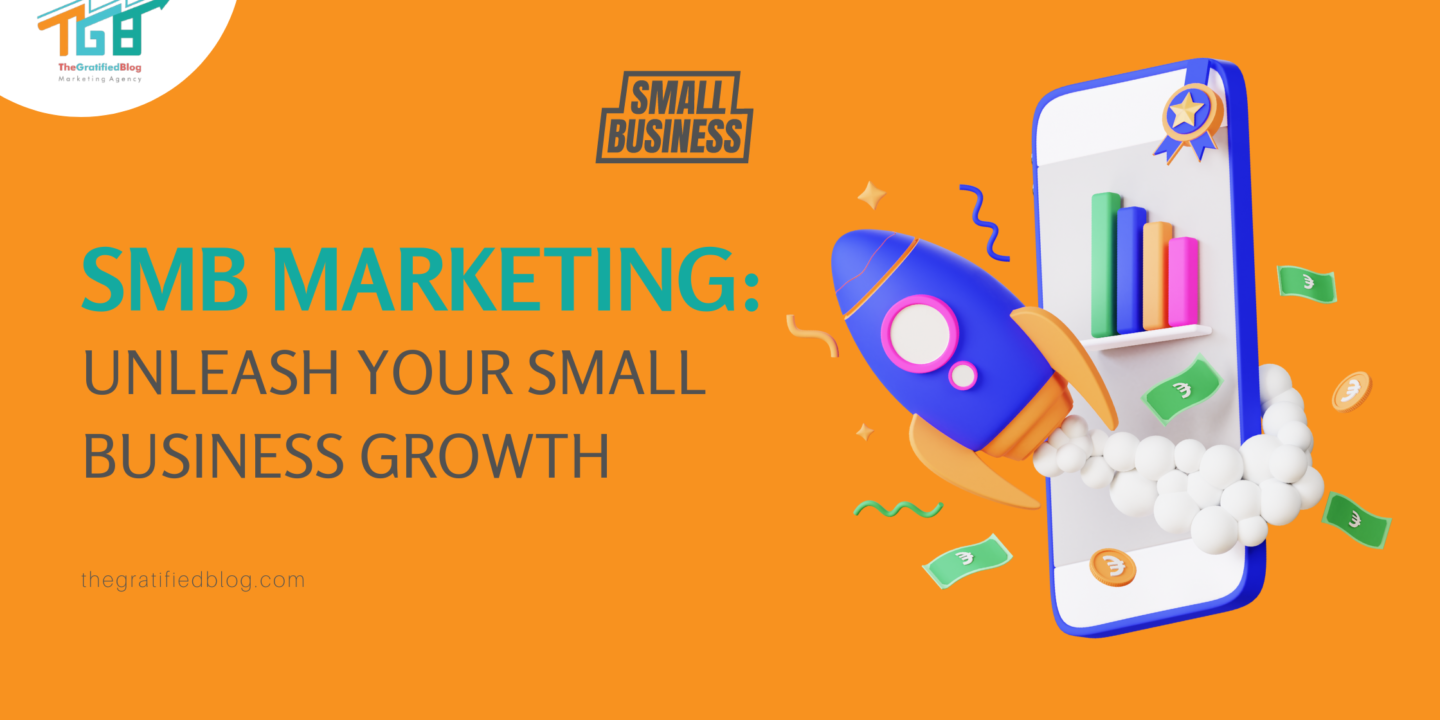
In the current dynamic business environment, Small and Medium-sized Businesses (SMBs) significantly foster economic growth and innovation. Nevertheless, thriving and succeeding require effective marketing strategies customized to address these businesses’ unique needs and challenges. This blog delves deep into SMB Marketing, examining crucial strategies and innovative approaches. From digital marketing tactics to establishing a solid brand presence and evaluating ROI, this comprehensive guide aims to empower SMBs with the knowledge and insights to make informed marketing choices and remain competitive in the constantly evolving business landscape.
So, let’s get started by understanding smb marketing
What Is SMB Marketing?
SMB Marketing refers to strategies, techniques, and activities specifically designed to promote and grow Small and Medium-sized Businesses (SMBs). It encompasses various marketing channels, tactics, and approaches tailored to the unique characteristics and challenges SMBs face.
Importance Of Marketing For SMBs Regarding Growth, Visibility, And Competitiveness
The importance of marketing for SMBs cannot be overstated, particularly regarding growth, visibility, and competitiveness. Here’s a closer look at each aspect:
Growth
Effective marketing catalyzes business growth, helping SMBs attract and acquire new customers, broaden their market presence, and enhance sales revenue. By implementing targeted marketing campaigns, SMBs can showcase and expand their audience reach with their products or services and seize growth opportunities within their specific industries.
Visibility
In today’s digital age, visibility is crucial for SMBs to stand out amidst competition and capture the attention of potential customers. Approaches such as search engine optimization (SEO) and social media marketing, creating content, and advertising online enhance visibility across digital platforms, making engaging with their intended audience and establishing brand awareness easier.
Competitiveness
SMBs often operate in competitive markets alongside giant corporations with substantial marketing budgets. Effective marketing strategies allow SMBs to level the playing field by differentiating themselves, showcasing their unique value propositions, and creating compelling messages that resonate with their target market. This competitiveness is not just about survival but also about thriving and carving out a distinct market position.
Having explored the concept of SMB marketing and the significance of marketing for SMBs, let’s now delve into the strategies involved in SMB marketing.
Critical Strategies For SMB Marketing

Let’s delve into the key strategies for SMB marketing in detail, starting with digital marketing and then moving on to local marketing approaches:
Digital Marketing for SMBs:
Website Optimization and SEO Strategies:
- Website Optimization: An excellently crafted and easy-to-navigate website forms the cornerstone of digital marketing for SMBs. Optimizing the website involves ensuring fast loading times, mobile responsiveness, intuitive navigation, and compelling content that engages visitors.
- SEO Strategies: SMBS needs to enhance its presence on search engine result pages (SERPs). This includes keyword research, on-page optimization (meta tags, headings, content), off-page optimization (backlinks, social signals), and technical SEO (site structure, sitemap, mobile-friendliness). Effective SEO can drive organic traffic, enhance brand credibility, and increase conversions.
Social Media Marketing Tactics for SMBs:

- Targeted Content Creation: SMBs can use social media platforms like Facebook, Instagram, Twitter, and LinkedIn to develop and distribute tailored content that connects with their audience. This includes posts, images, videos, stories, and infographics.
- Engagement and Interaction: Engaging with followers, responding to comments and messages, and fostering meaningful interactions can help SMBs build relationships, increase brand loyalty, and drive customer engagement.
- Paid Advertising: Social media advertising offers targeted options to reach specific demographics, interests, and behaviors. SMBs can leverage paid ads to promote products/services, attract visitors to their site, and capture leads.
Email Marketing Campaigns and Best Practices:

- Building Subscriber Lists: SMBs can grow their email lists by offering incentives (e.g., discounts, freebies), creating compelling opt-in forms, and leveraging social media and website traffic.
- Segmentation and Personalization: Segmenting email lists according to
Customers’ preferences, behaviors, and demographics allow SMBsto to provide customized content and promotions that appeal to recipients.
- Automation and Drip Campaigns: Using email marketing tools, SMBs can automate campaigns, send targeted messages at the right time, and nurture leads through drip campaigns, welcome series, and follow-ups.
Importance of Content Marketing for SMBs:
- Educational and Informative Content: Creating valuable content such as blogs, articles, guides, and infographics establishes SMBs as industry experts and provides value to their audience.
- SEO Benefits: Content marketing supports SEO efforts by targeting relevant keywords, attracting organic traffic, and earning backlinks from authoritative sources.
- Lead Generation and Brand Awareness: Compelling content attracts and engages prospects, drives traffic to the website, generates leads through gated content (e.g., ebooks, whitepapers), and increases brand visibility and credibility.
Local Marketing Approaches:

Leveraging Local SEO Techniques:
- Google My Business Optimization: Claiming and optimizing Google My Business (GMB) listings with accurate business information, photos, reviews, and updates helps SMBs appear in local search results and Google Maps.
- Local Keywords: Targeting local keywords (e.g., “near me,” “in [city name]”) in website content, meta tags, and blog posts improves visibility for local searches.
- Local Citations and Directories: Listing SMBs in local directories, chambers of commerce, and industry-specific platforms enhances local SEO and builds credibility.
Online Directory Listings and Reviews Management:
- Directory Listings: Ensuring consistent and accurate listings on online directories (e.g., Yelp, Yellow Pages, Bing Places) increases visibility and accessibility for local customers searching for SMBs.
- Reviews and Reputation Management: Encouraging and managing customer reviews on platforms like Google, Facebook, and Yelp influences purchasing decisions, builds trust, and improves online reputation.
Partnering with Local Businesses and Community Engagement:

- Collaborations and Partnerships: SMBs can collaborate with complementary local businesses for cross-promotion, joint events, and referral programs, expanding their reach and customer base.
- Community Engagement: Participating in local events, sponsoring community initiatives, and supporting charitable causes strengthens ties with the community and enhances brand visibility and goodwill.
By implementing these digital and local marketing strategies, SMBs can effectively maximize their online presence, connect with their target audience, drive engagement and conversions, and attain steady expansion in a competitive market.
Now, let’s delve into the key performance indicators (KPIs) associated with SMB marketing.
Key Performance Indicators (KPIs) For SMB Marketing
Here are four essential key performance indicators (KPIs) that are crucial for measuring the effectiveness of SMB marketing efforts:
- Customer Acquisition Cost (CAC): This KPI measures the cost incurred by an SMB to acquire a new customer. It includes expenses related to marketing campaigns, sales efforts, advertising, and any other costs directly associated with acquiring customers. A lower CAC indicates that the marketing strategies efficiently acquire new customers at a reasonable price.
- Conversion Rate: The conversion rate tracks the percentage of website visitors or leads that take an intended action, such as completing a purchase, signing up for a newsletter, or requesting more information. A higher conversion rate indicates that the marketing campaigns successfully persuade prospects to take the intended actions, leading to increased sales and revenue.
- Customer Lifetime Value (CLV): CLV is the total revenue a customer is expected to generate over their entire relationship with the SMB. It takes into account repeat purchases, upsells, and referrals. Monitoring CLV helps SMBs understand the long-term value of their customers and allows them to focus on retaining high-value customers and maximizing their lifetime value.
- Return on Investment (ROI): ROI measures the profitability of marketing campaigns by comparing the revenue generated against the costs incurred. It helps SMBs assess the effectiveness of their marketing strategies in generating revenue and achieving business goals. A positive ROI indicates that the marketing efforts create more revenue than the costs invested, while a negative ROI signals that adjustments may be needed to improve campaign performance.
FAQs
Q1. What are the primary advantages of SMB marketing?
A. SMB marketing helps small and medium-sized businesses increase brand visibility, attract new customers, drive sales growth, compete effectively in the market, and build long-term customer relationships.
Q2. What are some cost-effective marketing strategies for SMBs?
A. Cost-effective marketing strategies for SMBs include social media marketing, content creation, email campaigns, SEO optimization, local partnerships, and leveraging user-generated content.
Q3. What methods can SMBs use to gauge the effectiveness of their marketing efforts?
A. SMBs can measure marketing success using key performance indicators (KPIs) such as website traffic, conversion rates, lead generation, customer acquisition cost (CAC), social media engagement, email open rates, and ROI from marketing campaigns.
Conclusion
Given your understanding of SMB marketing, now is the time to prevent your small and medium-sized business from failing. Executing efficient marketing strategies customized to SMBs’ distinct requirements can be the key to success in today’s competitive landscape.
However, if you still have any questions related to the blog, please feel free to leave them in the comments section. We will be happy to answer them.
Thanks for reading 🙂








No Comments